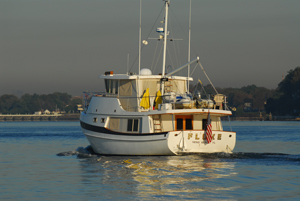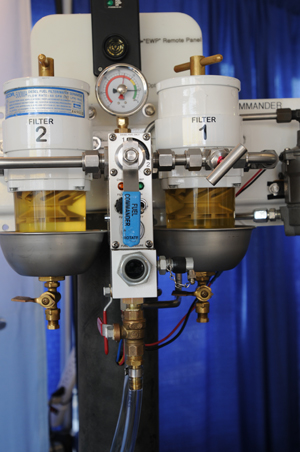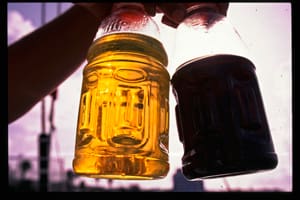Clean fuel is a power cruising priority, and it’s important to pay heed to what goes into the tank(s) and what’s sloshing around in the sediment bowl of every filter. But more often than not it’s what lies between the fuel fill and the primary filter that hides the problem.
Those plagued with plugged filters often focus on treating symptoms rather than tackling the problem itself. The right solution starts with an effective diagnosis of the upstream cause of the contamination, not just ridding the diesel fuel of suspended contaminants. The first step is to determine whether the trouble stems from a recent one-time bad batch of fuel, or if the fuel issue you’re facing is a symptom of a tank(s) that resembles the La Brea Tar Pits. If it’s the latter, it’s highly unlikely that a new round of filters will lead to a long-term cure. In fact, it’s likely that the filters will clog even more quickly on the next go round. It’s okay to repeatedly swap out filters in order to get home or find a harbor of refuge, but this is usually just a stopgap measure and it will take more invasive efforts to cure the problem.
 |
|
Ralph Naranjo |
|
With no alternative source of propulsion, power voyagers need reliable fuel systems. |
Fuel treatments have their place when it comes to lessening the impact of trace amounts of water and discouraging the growth of algae that feed on the sulfur found in diesel fuel. However, they are not a quick cure for already badly contaminated fuel that’s causing filters to clog in a matter of a few days or even a few hours. Unfortunately, using a biocide to kill the flora that’s causing the problem does not remove it from the fuel flow passing through the filters.
Polishing the fuel
Fuel polishing, with either an onboard system or a larger-capacity external unit is often used to solve the problem. The process mimics kidney dialysis filtering contaminants from the liquid via a filter or set of filters peripheral to those serving the normal fuel flow to the engine. These filters are larger in capacity and the fuel flow rate is often greater in order to handle the larger total volume of fuel that needs to be cleaned. In some cases, multiple inspection ports on the top of the tank(s) allows wide ranging access to the moveable suction wand, and this usually affords better results than when a single fixed pickup tube is used.
The initial results of fuel polishing ranges from good to excellent, depending upon how much of the cause of the contamination has been removed. When a bad load of fuel has been dumped into clean tanks, the chances are that such a dialysis approach will solve the problem, especially if there’s secondary tank space (either built in or temporary) to send the polished fuel. Less of a long-term solution occurs when the tank walls and baffles are coated with algae and asphaltene (a gooey, saturated hydrocarbon that settles out refined diesel fuel). In such cases, the embedded crud that’s left behind spawns a new batch of suspended contaminants and this can, and usually does happen at the very worst time — often when a boat is pounding into a seaway and the pitch, roll and yaw sets up a cocktail shaker-like condition in the fuel tanks.
Cleaning by hand
Commercial mariners know that the best solution to dirty tanks is to gain access to all internal surfaces and wipe, scrub or power spray them clean. The small craft owner may be able to accomplish the task with cotton rags and perhaps some WD-40 to loosen up more resistant sludge. When doing so, always count the rags before and after the operation. Many clean tanks have suffered from the lost rag syndrome. Really badly contaminated tank surfaces may need even more aggressive solvents, and such cleaning is best left to the pros. Be sure to wear a respirator, heavy duty gloves, eye protection and cover up if you’re planning a DIY tank cleaning. Also be sure to maintain good ventilation.
 |
|
Ralph Naranjo |
|
Duel filters and a switching valve like this one allow the engine to stay online while one filter is serviced — useful should one filter become clogged while the boat is in a tight spot. |
Dual primary filters with an A or B selector valve and perhaps even a built in fuel polishing system along with multiple tanks makes sense for long-distance power voyagers. It gives the crew a chance to self-recover from a bad batch of fuel and also allows you to keep the boat in optimum trim by shuttling fuel and polishing it at the same time.
Another handy fuel tank tactic of the long-range cruiser is the use of a Baja filter to sample fuel prior to taking on a full load. This multilayer screen type portable filter is a superior crud catcher, and when a passagemaker must take on fuel from a questionable source, this portable filter can be used to test the fuel or even pre-filter the entire load out. The latter is a slow arduous task, but it beats contaminating the fuel tank(s).
Water alarms
Filter manufacturers such as Racor offer water alarms and vacuum gauges that help give the crew a heads up regarding potential problems. The conductivity sensor placed in the base of the primary filter responds to water’s ability to complete a circuit. When fuel at the bottom of the sediment bowl is displaced by denser water, the alarm will sound. An experienced crew drains away that water and as they enter the time, date and engine hours in their engine log they check to see when they last performed the same feat. Some residual moisture is to be found in all fuel, but it’s when weekly purges turn into a daily occurrence that some fuel forensics is necessary.
The vacuum gauge at the filter outlet measures resistance to fuel flow and how hard the fuel pump must work to get fuel through your boat’s filters and plumbing. New clean elements should show the lowest reading. As filters clog with crud there’ll be a restriction in flow and a corresponding increase in suction. At some point the fuel flow will become so impaired that the engine will develop RPM oscillations and other performance robbing signs of fuel starvation, the gauge reading where such surging occurs should be noted. In the future, the filter element(s) should be changed before that point is reached. Keeping track of engine hours and how it relates to vacuum gauge readings provides some valuable data as to fuel quality and/or tank conditions.
—————
Ralph Naranjo is a freelance writer and photographer based in Annapolis, Md. He is also a U.S. Sailing Master Trainer, part of U.S. Sailing’s National Faculty and a past chairman of its Safety at Sea Committee. He is the author of Boatyards and Marinas.

